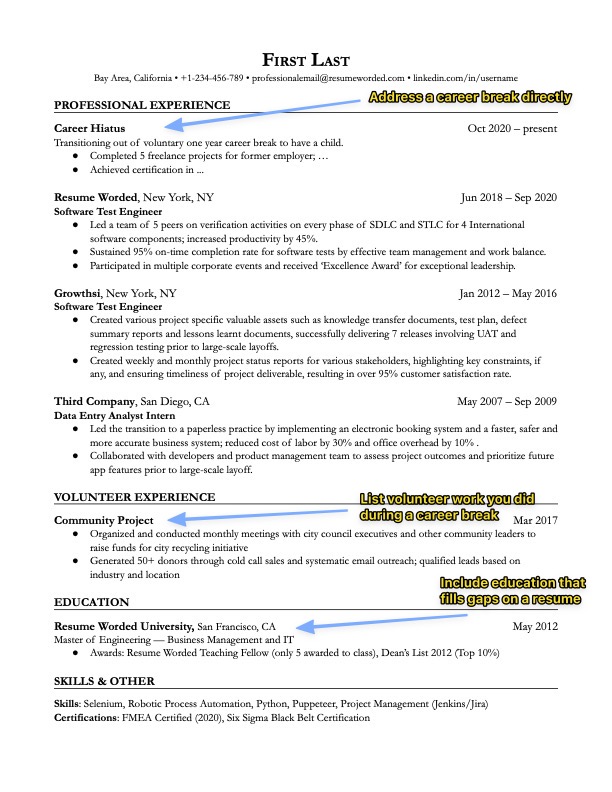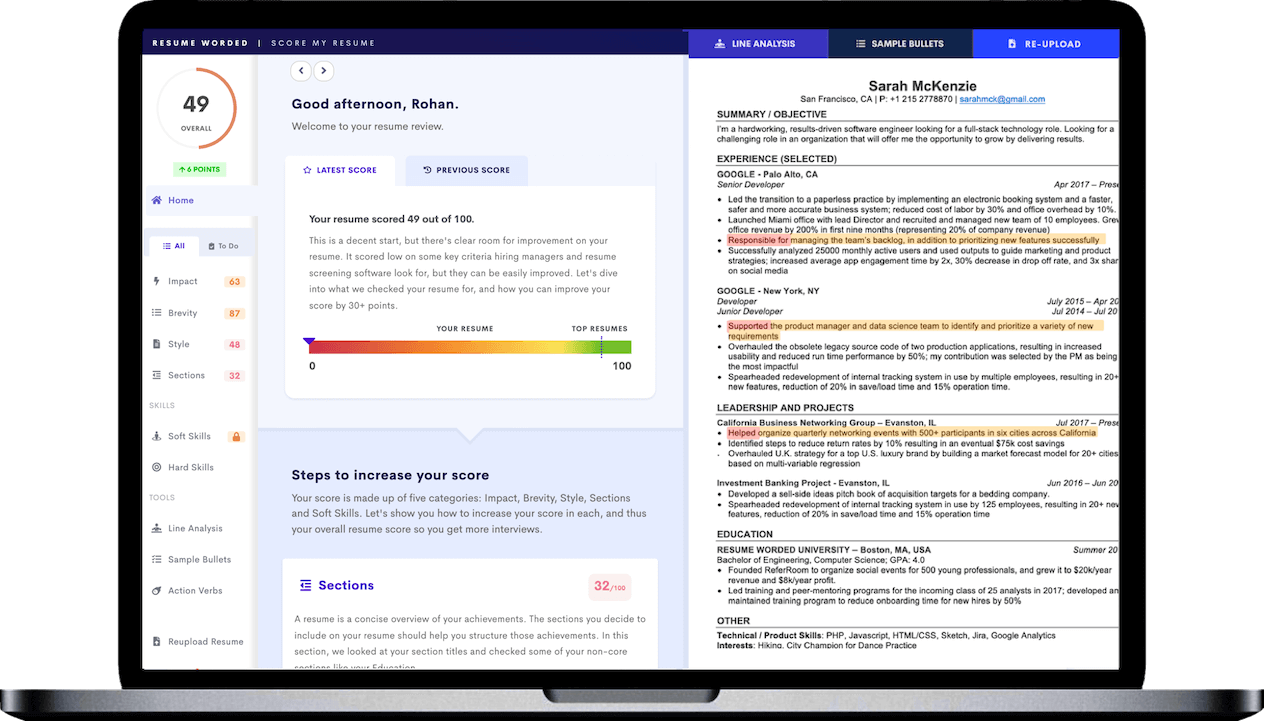“Can you explain this gap on your resume?”
It’s the question every job seeker dreads. It isn’t always easy to explain a gap in employment, even if you have a good reason — and if you don’t, it might seem like an insurmountable challenge.
But an employment gap doesn’t have to be a red flag to employers. Explaining the reason behind it simply, honestly, and directly is the best way to deal with any kind of gap on your resume.
Let’s start with a few basic principles to keep in mind when navigating employment gaps on your resume (and beyond).
Rules for explaining a resume gap
Need to explain an employment gap on your resume? Here’s how.
- Don’t draw attention to it. If you have a very short gap (less than 6 months), you may be able to get away without explaining it at all.
- Don’t try to hide it. On the other hand, you shouldn’t tie yourself in knots trying to hide a gap — it really isn’t that big a deal.
- Be direct. It’s better to explain a resume gap upfront instead of waiting to be asked about it.
- Accentuate the positive. If you did any freelance work, volunteering, or retraining during your time off, focus on that.
- Less is more. Don’t spend too much time explaining a resume gap or going into unnecessary detail — address it and move on.
- Keep it professional. Always try to come up with a standard, professional reason for your employment gap (scroll down for some examples you can use).
- Don’t lie. Above all else, never lie on your resume or during the hiring process. If you’re asked a direct question, answer it honestly.
To address any gaps in your resume, consider utilizing your freelance work, volunteer experience, or personal projects. To determine whether you've done this effectively, upload your resume to the tool below — it will scan it and offer suggestions for improvement.
Good reasons for having a resume gap
Struggling to come up with a “good enough” reason for having a resume gap? First off, here’s the good news: employers don’t really care about your employment gap.
What they want to know is whether or not it’s a red flag related to something they do care about — for example, if you were fired for cause or have a tendency to quit jobs without notice. As long as you can rule out some of the most common causes for concern, your actual reason isn’t all that important.
The reason you give for an employment gap should be professional, concise, and easy to understand. For example:
Good: “I was let go due to organizational changes.”
Bad: “I was let go because I didn't get along with my manager.”
Avoid getting personal with your reasons — even if the real reason was personal. For example:
Good: “I took a break to focus on personal development and education.”
Bad: “I took time off to deal with personal issues.”
If you can’t avoid getting a little personal, keep it as brief and surface-level as possible. For example:
Good: “I took some time off to care for a sick family member.”
Bad: “I had to move across the country because my aunt was diagnosed with Alzheimer’s and nobody else wanted to look after her.”
Above all, don’t mention anything that will give a recruiter further cause for concern. You want to indicate that whatever caused the employment gap is fully in the past (even if that’s not a hundred percent true). For example:
Good: “I took some time off after the birth of my child.”
Bad: “I wanted to be a stay at home parent but we can’t afford it right now, so I’m looking for a job until we can.”
How to explain an employment gap on a resume (with examples)
Option #1: Leave out the explanation
You can downplay smaller employment gaps by listing years on your resume instead of months. For example, it’s okay to put:
Position #1, 2022-Present
Position #2, 2020-2022
Instead of:
Position #1, July 2022-Present
Position #2, January 2020-April 2022
Don’t do this to hide a longer period of unemployment, but for gaps of up to a few months, it’s perfectly fine.

Option #2: Include a short explanation
If the gap is long enough that you can’t easily gloss over it, the next best step is to explain it as briefly as possible. In between the jobs where the gap is, write a short headline like
“Leave of absence” or “Career hiatus” with a one-line explanation underneath. For example:
Leave of absence, 2020-2021
Took hiatus from work to be a stay-at-home parent.

Option #3: Showcase experience gained during an employment gap
Generally, you should avoid listing an employment gap as if it were a job itself — for example, don’t list “Stay at home mom” or “CEO of household” as if it’s a professional job. That said, it is okay to list a career hiatus in your Work Experience section as long as you have relevant accomplishments to list from that period of time.
Things it’s okay to list include:
- Volunteering
- Freelance work
- Side hustles
- Personal projects
- Education (including short courses)
If you did any of these, you probably picked up more than a few transferable skills, so try to highlight these with 1-2 bullet point accomplishments. For example:
If you volunteered:
Volunteered at a local non-profit organization, where I gained experience in event planning, fundraising, and community outreach.
If you did freelance work:
Freelanced as a writer and editor, developing skills in project management, communication, and meeting deadlines.
If you took a course:
Took courses in digital marketing and SEO to enhance my skills in the marketing industry, demonstrating a commitment to personal and professional growth.

Beyond the resume: Explaining an employment gap throughout the application process
How to explain an employment gap in your cover letter
You don’t need to address a gap in employment in your cover letter, but you can if it helps put your mind at ease. Don’t go into too much detail about the gap itself or the reasons behind it — instead, focus on the skills you gained during that time and how they make you a good fit for the role. Any references to an employment gap shouldn’t take up more than 1-2 sentences in your cover letter.
If you're unsure how to talk about a gap on your cover letter, use this cover letter generator. It's built by hiring managers and you can ask it for a hiring manager that subtly describes your gap without drawing too much attention to it.
How to explain an employment gap in an interview
If you have any kind of gap in employment — even a seemingly insignificant one — you should come prepared to answer questions about it in an interview. Like any other common interview question, the key is to practice what you want to say beforehand. Try to:
- Keep your answer to 30 seconds or so — don’t dwell on it.
- Avoid saying anything negative about a past employer. Come up with a diplomatic-sounding reason and leave blame or emotion out of it.
- Bring it back around to the job. After you’ve explained why the gap is there, mention the skills you acquired during that time and tie it into what you know about the job. For example, “During that time, I enrolled in a team management course. I saw that you mentioned team management in the job description, so can you tell me more about that?"










